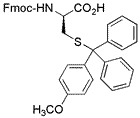Fmoc-S-4-methoxytrityl-D-cysteine is widely utilized in research focused on:
- Peptide Synthesis: This compound serves as a protecting group for cysteine residues in peptide synthesis, allowing for the selective modification of peptides without affecting the cysteine's thiol group.
- Drug Development: It plays a crucial role in the development of peptide-based therapeutics, particularly in designing drugs that target specific biological pathways.
- Bioconjugation: The chemical is used in bioconjugation processes, where it helps in attaching peptides to other biomolecules, enhancing the stability and efficacy of therapeutic agents.
- Research in Cancer Therapy: Its applications extend to cancer research, where it aids in creating targeted therapies that can selectively deliver drugs to cancer cells.
- Protein Engineering: This compound is valuable in protein engineering, facilitating the creation of modified proteins with improved properties for various industrial applications.
General Information
Properties
Safety and Regulations
Applications
Fmoc-S-4-methoxytrityl-D-cysteine is widely utilized in research focused on:
- Peptide Synthesis: This compound serves as a protecting group for cysteine residues in peptide synthesis, allowing for the selective modification of peptides without affecting the cysteine's thiol group.
- Drug Development: It plays a crucial role in the development of peptide-based therapeutics, particularly in designing drugs that target specific biological pathways.
- Bioconjugation: The chemical is used in bioconjugation processes, where it helps in attaching peptides to other biomolecules, enhancing the stability and efficacy of therapeutic agents.
- Research in Cancer Therapy: Its applications extend to cancer research, where it aids in creating targeted therapies that can selectively deliver drugs to cancer cells.
- Protein Engineering: This compound is valuable in protein engineering, facilitating the creation of modified proteins with improved properties for various industrial applications.
Documents
Safety Data Sheets (SDS)
The SDS provides comprehensive safety information on handling, storage, and disposal of the product.
Product Specification (PS)
The PS provides a comprehensive breakdown of the product’s properties, including chemical composition, physical state, purity, and storage requirements. It also details acceptable quality ranges and the product's intended applications.
Certificates of Analysis (COA)
Search for Certificates of Analysis (COA) by entering the products Lot Number. Lot and Batch Numbers can be found on a product’s label following the words ‘Lot’ or ‘Batch’.
*Catalog Number
*Lot Number
Certificates Of Origin (COO)
This COO confirms the country where the product was manufactured, and also details the materials and components used in it and whether it is derived from natural, synthetic, or other specific sources. This certificate may be required for customs, trade, and regulatory compliance.
*Catalog Number
*Lot Number
Safety Data Sheets (SDS)
The SDS provides comprehensive safety information on handling, storage, and disposal of the product.
DownloadProduct Specification (PS)
The PS provides a comprehensive breakdown of the product’s properties, including chemical composition, physical state, purity, and storage requirements. It also details acceptable quality ranges and the product's intended applications.
DownloadCertificates of Analysis (COA)
Search for Certificates of Analysis (COA) by entering the products Lot Number. Lot and Batch Numbers can be found on a product’s label following the words ‘Lot’ or ‘Batch’.
*Catalog Number
*Lot Number
Certificates Of Origin (COO)
This COO confirms the country where the product was manufactured, and also details the materials and components used in it and whether it is derived from natural, synthetic, or other specific sources. This certificate may be required for customs, trade, and regulatory compliance.


